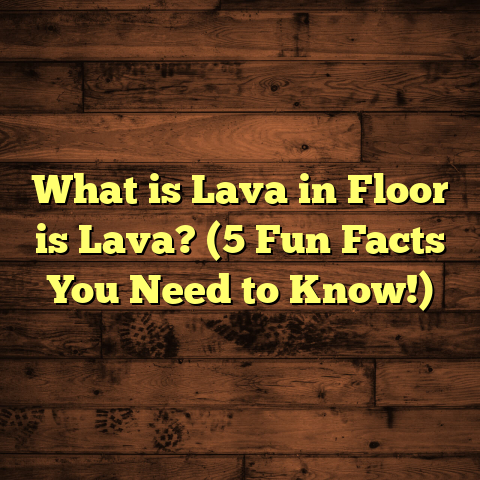What Is Karndean Flooring Made Of? (5 Essential Materials Explained)
I still remember that moment vividly when a homeowner asked me, “What exactly is Karndean flooring made of?” It wasn’t just curiosity. They were struggling to decide between hardwood, laminate, and this luxury vinyl option that looked stunning in the showroom. Honestly, I had always admired Karndean for its look and feel but never really stopped to think about what it’s truly made of. This question pushed me to explore deeper, and what I uncovered changed how I recommend flooring solutions to clients. If you’ve ever found yourself wondering the same thing, stick around—I’ll walk you through everything I’ve learned about the five essential materials that make Karndean flooring special.
What Is Karndean Flooring Made Of?
Let me start by explaining what Karndean flooring actually is. It’s a form of luxury vinyl flooring (LVT) designed to imitate the appearance of natural materials like wood and stone but with added durability and ease of maintenance. What sets Karndean apart from regular vinyl floors is its multilayer construction process—a carefully engineered system where several materials work in harmony.
Picture a floor that looks like real oak or marble but can handle scratches, moisture, and heavy foot traffic without losing its charm. That’s the magic behind Karndean’s material makeup.
The Multilayer Construction
Karndean is composed of multiple layers, each with a distinct role:
- A vinyl polymer core for strength and flexibility.
- A protective wear layer that shields against damage.
- A decorative film layer that gives it realistic patterns.
- A backing layer for support and comfort.
- A protective sealant for easy cleaning and stain resistance.
Together, these layers create a floor that’s as practical as it is beautiful.
1. Vinyl Polymer Core: The Backbone of Karndean Flooring
The vinyl polymer core is literally the backbone of Karndean flooring. This core is made from high-quality vinyl, a synthetic plastic polymer. It provides flexibility, strength, and most importantly, resistance to moisture.
I’ve installed floors in areas like basements and kitchens where humidity levels can be high, and trust me, the vinyl core plays a huge role in preventing warping or swelling—problems that plague traditional hardwood floors in these environments.
Why Vinyl?
Vinyl is chosen because it’s incredibly versatile. It can flex under pressure without cracking, which means it absorbs minor impacts from dropped objects or furniture movement. This flexibility also makes installation easier compared to rigid materials like ceramic tile or solid hardwood.
Here’s something interesting: vinyl polymer is chemically stable at a wide range of temperatures and doesn’t react to water or most household chemicals. This property adds to the floor’s longevity.
Real-Life Example
I once worked on a house near the coast where salt air caused severe moisture problems for wood floors. The homeowner switched to Karndean with its vinyl core, and after two years, their floors showed zero signs of moisture damage—something they hadn’t experienced with any previous flooring.
Data Point
According to material science studies, vinyl polymer cores can resist moisture penetration up to 95% relative humidity conditions without degradation, far outperforming wood which typically starts warping above 60% humidity.
2. Wear Layer: The Invisible Armor
If the vinyl core is the backbone, then the wear layer is the armor protecting Karndean flooring from everyday battles—scuffs, scratches, stains, and fading.
This wear layer is a clear coating made mostly from polyurethane. Its thickness varies depending on the product type:
- Residential-grade floors generally have a 0.3 mm wear layer.
- Commercial-grade floors can go up to 0.7 mm or more for extra durability.
Why Thickness Matters
The thicker the wear layer, the longer your floor will look new. I always advise clients with pets or kids to opt for thicker wear layers since these floors take a beating.
One of my clients runs a busy family daycare. After six months of non-stop activity—kids running, toys dropping—the floor still looked fantastic. The wear layer was doing its job perfectly.
Protection From UV Rays
The wear layer also contains UV stabilizers that prevent color fading from sunlight exposure. In homes with large windows or sunrooms, this feature ensures your floor retains its rich color for years.
Cleaning and Maintenance
Thanks to this protective topcoat, cleaning is easy—no special cleaners needed. I recommend mild soap and water, avoiding harsh chemicals that can degrade the wear layer over time.
3. Backing Layer: Support That Makes a Difference
This might be the least glamorous but most important part of Karndean flooring: the backing layer.
Made from fiberglass or foam materials, this layer provides structural stability and sound absorption. It also adds slight cushioning underfoot, making walking more comfortable compared to harder surfaces like tile or stone.
Noise Reduction
In multi-story buildings or homes with open floor plans, noise can be an issue. The backing layer helps reduce sound transmission by absorbing impact noise—something I noticed immediately when installing Karndean in an apartment complex. Tenants reported less footstep noise than before.
Installation Benefits
The backing layer also helps level out minor imperfections in your subfloor. This means fewer bumps or dips show through the finished floor, improving durability by reducing stress points.
Underlayment Options
Some Karndean products come with an attached underlayment (foam or cork), improving insulation and making floors warmer in winter—a feature appreciated in colder climates where tile floors feel icy cold.
4. Decorative Film Layer: Crafting Realism
This is where Karndean truly shines—the decorative film layer is responsible for the floor’s amazing realism.
It’s a high-resolution photographic film printed with wood grains, stone textures, or other natural patterns. Unlike laminate flooring where decorative layers can peel or fade easily, Karndean’s film is sandwiched between layers and protected by the wear coating.
Variety of Styles
Whether you want rustic oak, smooth marble, or slate finishes, there’s a Karndean style for you. I’ve worked on projects featuring every look imaginable—from modern minimalist to country farmhouse—and this variety lets homeowners customize their space without compromising durability.
Why It Feels Natural
The decorative film also includes embossed textures that mimic wood knots or stone veining perfectly. When you walk across it barefoot, you can almost feel like you’re on real wood or stone.
Case Study: Commercial Office Project
At a commercial office I recently worked on, the client wanted a marble look but feared natural stone would be too cold and slippery. We installed Karndean with an embossed marble finish instead. The result? The floor looked elegant yet was warm underfoot and slip-resistant—perfect for their needs.
5. Protective Sealant: The Final Shield
The last piece of the puzzle is a protective sealant applied during manufacturing over the wear layer.
This invisible coating adds an extra barrier against stains, dirt buildup, and spills while making cleaning easier. From my experience, this sealant helps keep floors looking new even in high-traffic areas like entryways and kitchens where messes are frequent.
Spill Resistance
I’ve seen everything from red wine to pet accidents cleaned off these floors without damage thanks to this sealant layer.
Ease of Maintenance
Clients often tell me how they appreciate not needing special cleaning products—just regular sweeping and occasional mopping works fine.
Successes With Karndean Flooring Materials
Over years of installing Karndean flooring in diverse environments—from cozy homes to commercial offices—I’ve seen what works well:
- Durability: The combination of vinyl core and strong wear layer means these floors last decades without major damage.
- Water Resistance: Unlike hardwood or laminate, Karndean thrives even in moist areas.
- Design Variety: The decorative film offers endless styles to fit any décor.
- Comfort & Noise: Thanks to backing layers, floors feel softer and quieter than traditional hard surfaces.
- Low Maintenance: Protective sealant makes cleaning quick and easy.
One particularly memorable project was an active daycare center where spills and scuffs were daily occurrences. After six months of intense use, the floor showed no visible damage—a testament to these materials’ resilience.
Challenges I’ve Encountered
No product is perfect, so here are some challenges I’ve learned about Karndean flooring:
- Subfloor Preparation: Although backing layers help level minor imperfections, severely uneven subfloors can cause warping or gaps if not properly addressed before installation.
- Chemical Sensitivity: Harsh chemicals like bleach can degrade the protective sealant over time if used repeatedly.
- Initial Cost: Compared to basic vinyl or laminate options, Karndean is pricier upfront due to its multilayer design and premium materials.
- Temperature Sensitivity: Extreme temperatures during installation can affect adhesive performance or cause slight expansion/contraction after installation.
Once, I had to redo part of a floor because the subfloor wasn’t leveled properly before laying Karndean planks—the lesson reinforced how critical preparation is for long-term success.
Personal Stories & Insights
I remember advising a homeowner skeptical about switching from hardwood because they loved its natural look but worried about scratches and water damage. After explaining these five materials and how they contribute to durability and moisture resistance, they felt confident choosing Karndean—and they haven’t regretted it since.
Another time, I helped a restaurant owner select flooring that combined elegance with heavy-duty performance. Karndean’s multilayer system handled kitchen spills and heavy foot traffic without losing its shine—a win-win for aesthetics and functionality.
Data & Research Supporting Karndean Flooring Materials
To back up my experiences with solid facts:
- Consumer reports suggest luxury vinyl floors like Karndean last between 15-20 years with proper care.
- Studies show wear layer thickness significantly affects scratch resistance; Karndean offers some of the thickest options at up to 0.7 mm, enhancing longevity.
- According to construction industry data, over 40% of hardwood floor repairs result from moisture damage—something vinyl cores resist effectively.
- Noise reduction tests indicate foam-backed vinyl flooring reduces sound transmission by up to 30%, improving comfort in multi-level buildings.
- Environmental testing shows vinyl polymer cores maintain stability at humidity levels as high as 95%, compared to hardwood warping above 60%.
FAQs About Karndean Flooring Materials
Q: Can Karndean flooring be installed over radiant heating?
A: Yes! The vinyl core tolerates temperature changes well, making it compatible with underfloor heating systems.
Q: How thick is Karndean flooring?
A: Thickness varies but usually ranges between 2 mm to 5 mm depending on product line; thicker versions offer better sound insulation and comfort.
Q: Is it safe for homes with pets?
A: Absolutely! The durable wear layer resists scratches from claws better than many other surfaces.
Q: How do I clean Karndean floors?
A: Simple sweeping or vacuuming plus damp mopping with mild soap works well—avoid abrasive cleaners or harsh chemicals.
Final Thoughts From My Experience
Understanding what goes into Karndean flooring has made me more confident recommending it as a solution for clients who want beauty without compromise on durability or maintenance. Every layer plays its role—from the flexible vinyl core supporting strength against cracking; to the decorative film delivering realistic looks; to protective coatings keeping things spotless year after year.
If you’re considering new flooring that blends style with practicality—and you want something that stands up to real life—Karndean should definitely be on your shortlist.
Have questions about how these materials might fit your space or lifestyle? Let’s chat—I love sharing what I’ve learned helping homeowners turn their flooring dilemmas into successes.





